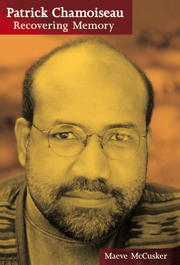Book contents
- Frontmatter
- Contents
- Acknowledgements
- Abbreviations
- Introduction
- 1 Beginnings: The Enigma of Origin
- 2 ‘Une tracée de survie’: Autobiographical Memory
- 3 Memory Re-collected: Witnesses and Words
- 4 Memory Materialized: Traces of the Past
- 5 Flesh Made Word: Traumatic Memory in Biblique des derniers gestes
- Afterword
- Notes
- Bibliography
- Index
5 - Flesh Made Word: Traumatic Memory in Biblique des derniers gestes
- Frontmatter
- Contents
- Acknowledgements
- Abbreviations
- Introduction
- 1 Beginnings: The Enigma of Origin
- 2 ‘Une tracée de survie’: Autobiographical Memory
- 3 Memory Re-collected: Witnesses and Words
- 4 Memory Materialized: Traces of the Past
- 5 Flesh Made Word: Traumatic Memory in Biblique des derniers gestes
- Afterword
- Notes
- Bibliography
- Index
Summary
This study began with a reading of Chamoiseau's first novel, Chronique des sept misères, and reaches its end with his most recent, and most ambitious, to date, Biblique des derniers gestes (2002). The striking similarity in the very titles of the two texts gestures towards a continuity of thematic preoccupation, and indeed of structure, across the œuvre as a whole. This coherence can be seen for example in the fact that Biblique, like Texaco and Solibo, opens in the debased contemporary present, and then projects back in time, uncovering a more vital, if painful, Creole past. The novel's hero, Balthazar Bodule-Jules (known also as Bibidji), is typical: he is a childless visionary, ‘anormalement stérile’ (p. 43), much like Marie-Sophie in Texaco, or the eponymous but anonymous hero of L'Esclave vieil homme et le molosse. The familiar personnel (elderly protagonist, hesitant and self-critical marqueur de paroles, Césaire himself) all figure as so many indicators of an instantly recognizable literary mode. And, like Marie-Sophie in Texaco, Bibidji is himself a writer, whose reflections on literature and on the writing process appear in ‘feuillets’, rather than the ‘cahiers’ of the earlier novel; this common occupation lends both novels a highly metafictional quality.
Moreover, like all Chamoiseau's previous works, which can be read though an optic of loss and lament (from the autobiographies which mourn the disappearance of the magical apprehension of the child's world, to the individual novels which register the demise of local customs and traditions), the very title of Biblique des derniers gestes connotes a sense of nostalgia.
- Type
- Chapter
- Information
- Patrick ChamoiseauRecovering Memory, pp. 127 - 149Publisher: Liverpool University PressPrint publication year: 2011



